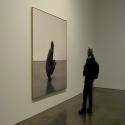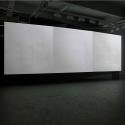Kim, Shin il
Other Names: 김신일; 金信日
"I draw object using no color but single pressed line on papers, a minimal gesture on a white page, so that they can be seen or not according to the angle of light. After hundreds of pressed line drawings on paper, they are animated by 30 drawings per second.
It is a way to transfer object to the idea of exist and non-exist together at the same time based on the idea of Buddhism and ‘the golden mean’ that is one of the eastern philosophies. The definition of ‘the golden mean’ is a balance between two extreme positions, ideas, etc.
These ideas can be melted into artwork by drawing human’s movement meeting with other objects, the most common thing we have, because the idea of the philosophies should be remained within the most common life. Therefore, I observe relationship between people and people, people and objects and me and other."
--Shin il Kim, Artist Statement, 2003
"An aesthetic that developed and evolved in China is that of emptiness. It became a key principle in Classical Chinese Landscape painting beginning after the Han Dynasty and lasting through the modern period. This is a philosophical as well as an aesthetic principle, a love for simplicity. Emptiness left ample space for viewer's imagination to what an artist 'suggested' in their art. In Shin il Kim's work, the simplicity of empty space of the raw incised paper, epitomizes empty space as a key principle. In the modern West, with expanding horizons and greater capacity to meet every human challenge, it seems imaginable for human endeavors to do away with limits. Growth has been part of American expectations and seems inevitable, more not less is in our future. However, given the recent economic crisis, the findings of ecology, and the realization that economically things have not really expanded since 1970, there is good reason to pursue the goals of sustainability – an equinamimity with all the earth and its peoples."
--by Robert Lee, Director, Asian American Arts Centre, for ARTRAIN show catalog 2008



